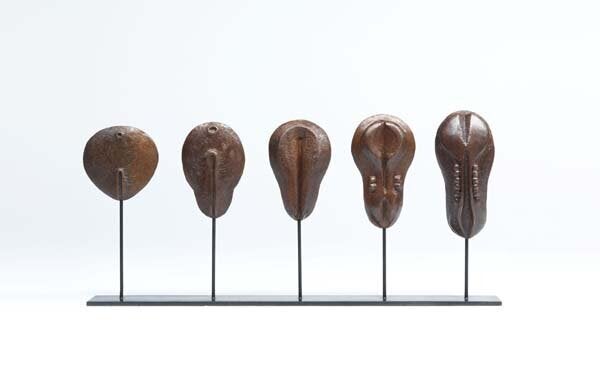It's not often that science graduates become artists. Briony Marshall has gone one step further. She uses science - more specifically biochemistry and molecular biology - as the model for her sculptures and drawings. Her exhibition at the Pangolin London is entitled Life Forming. Its centrepiece is her interpretation of the DNA molecule, The Helix of Life (below), constructed on the 60th anniversary of DNA's discovery. It's a painstaking two-metre high reconstruction in bronze of a single twist of the molecule comprised of the carbon, hydrogen, nitrogen, oxygen and phosphorous atoms with each of the 600 represented by a human figure. The arms and legs connect each atom to the next, representing the chemical bond. The figures were originally made in wax before being cast in bronze. "It says we are all connected together," she tells me. "Through different relationships between people based on quite simple principles, we can develop quite complex societies, quite complex structures within society but at the end of the day it is all built on individuals."

Marshall graduated in biochemistry from Oxford University back in 1997. Yet from a small child she'd been interested in art but never quite knew in which direction to go. She worked in the internet bubble after university and a redundancy package she received after that bubble burst gave her the means to embark on an art degree from the Art Academy in south London. Here she discovered sculpture as her favoured medium. In 2011 she spent more than a year as Sculptor in Residence at King's Place. Her fascination with biochemistry never left her, however, and she realised that she viewed the world through a scientific lens. "I get to do the two things I enjoy the most. I love making the work but I also enjoy the research and working out how this might translate into a sculptural language."
In one exhibit, CS 6-10 Maquettes (below), six large sculptures cast in bronze explore stages 6 - 10 of the Carnegie stages of embryonic growth, beginning with a flat disc with a single line of symmetry and ending with the stage in which the spinal column is beginning to form and the embryo is beginning to develop its curved form. Marshall's researches showed her that many other elements are forming at the same time, and another drawing represents the development of heart cells. Other sculptures continue this theme of life developing. "It's a rich seam I'm mining. There are such amazing things that happen in nature and one can explore the other layers of meaning to what's going on." Marshall speaks of her frustration as a science student in feeling that, unlike her friends who were learning about how the world worked through history or politics, she inhabited what seemed a separate little world. "In fact, I was learning different physical laws and perhaps an insight into why things happen. I guess my art practice is the way for me to unpick truth or reality of what's going on together with a subtle element of personal opinion that looks at the earth's limited resources and the fragility of life.

Despite straddling both art and science, Briony Marshall can see both differences and commonalities between the two disciplines. Science has to be rooted in empirical evidence, yet both can contain those Eureka moments, albeit in art's case more small scale though more frequent. One shared quality that this exhibition illustrates most profoundly is how art and nature begin with nothing, an idea or a seed is conceived and order and form emerges.
LIFE FORMING runs at Pangolin London, King's Place until 15 June 2013.